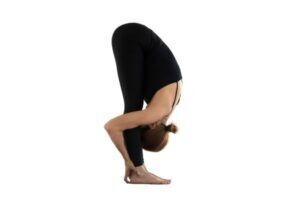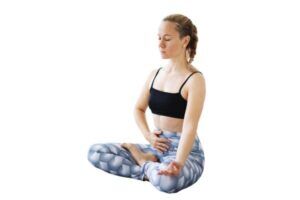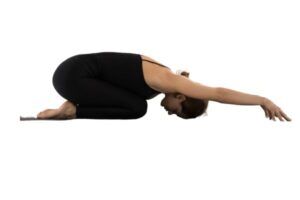In today’s fast-paced world, getting good sleep can be hard. With the constant buzz of technology, stress from work, and the pressures of daily life, many of us struggle to unwind and find restorative sleep. However, incorporating yoga into your daily routine can be a powerful tool for promoting better sleep.
How Can Yoga Improve Sleep?
Yoga can significantly enhance sleep quality by addressing physical tension and mental stress. Practices such as gentle asanas (yoga poses) encourage relaxation of the muscles and ease physical discomforts that may hinder sleep. Additionally, yoga incorporates mindful breathing and meditation techniques which help calm the mind, reducing anxiety and facilitating a smoother transition into sleep. The overall effect of regular yoga practice is an improvement in sleep duration and quality, contributing to better overall health and well-being.
Here are Some Yoga Poses to Do Every Day for Better Sleep
Standing Forward Bend (Uttanasana)
The Standing Forward Bend, or Uttanasana, is a foundational yoga pose that involves bending forward from the hips, extending the spine, and relaxing the neck. This pose helps to stretch the hamstrings and calves, and it can release tension in the back and neck.
How to Do It:
1.From Tadasana, exhale and hinge at your hips to fold forward.
2.Keep your spine long as you fold.
3.If your hamstrings are tight, you can bend your knees slightly.
4.Allow your head and neck to relax as you hang in this position.
5.You can hold onto your shins, ankles, or the floor, depending on your flexibility.
Corpse Pose (Savasana)
Corpse Pose, or Savasana, is a deep relaxation pose used typically at the end of a yoga session. It involves lying flat on the back with the arms and legs comfortably spread apart, palms facing upward. This pose helps to relax the body completely and calms the mind, facilitating integration of the benefits of the yoga practice.
How to Do It:
- Lie on your stomach with your palms flat on the mat next to your chest.
- Press into your palms as you lift your chest off the mat, keeping your elbows close to your body.
- Lengthen through the crown of your head and engage your back muscles.
- Hold the pose for 15-30 seconds, breathing deeply.
- Exhale as you release back down to the mat.
Pranayama (Breathing Techniques)
Pranayama comprises various yogic breathing techniques designed to control and extend the breath, which is vital for energizing and balancing the body and mind. Pranayama practices enhance oxygen intake, cleanse internal systems, and can have a profound impact on mental clarity and calmness.
How to Do It:
- Sit comfortably with a straight spine, on the floor or a chair with feet flat.
- Place one hand on the abdomen, one on the chest to feel breath.
- Inhale slowly through the nose, filling the abdomen, rib cage, then upper chest.
- Hold your breath at the top for a moment (if comfortable).
- Exhale slowly through nose, releasing upper chest, rib cage, then tighten abdomen.
- Repeat for minutes, focus on breath sound and sensation, aim for smoother, longer breaths.
Thunderbolt Pose (Vajrasana)
Thunderbolt Pose, or Vajrasana, is a simple yet powerful sitting yoga posture that involves sitting on the heels with the calves tucked under the thighs. It is one of the few poses that can be performed right after eating, as it aids in digestion. The pose helps to strengthen the leg muscles, improve posture, and calm the mind.
How to Do It:
- Kneel on the floor with your knees close together and your big toes touching.
- Sit back on your heels, keeping your spine straight.
- Place your hands on your thighs, palms facing down.
- Relax your shoulders and breathe deeply, remaining in this position for a few minutes.
Child’s Pose (Balasana)
Child’s Pose, or Balasana, is a restorative yoga posture that mimics the natural fetal position. It’s often used as a resting position between more challenging poses and is excellent for relieving stress and fatigue. This pose stretches the hips, thighs, and ankles while relaxing the muscles of the spine, shoulders, and neck.
How to Do It:
- Start by kneeling on the yoga mat with your big toes touching and knees apart.
- Slowly lower your torso down towards the mat, extending your arms in front of you or placing them alongside your body.
- Rest your forehead on the mat and focus on deep breathing, allowing your belly to expand with each inhale and contract with each exhale.
- Hold the pose for 1-3 minutes, gradually releasing any tension in the body.
Conclusion
Incorporating these yoga poses into your daily routine can be a game-changer for improving the quality of your sleep and enhancing your overall well-being. Whether practiced individually or as part of a bedtime routine, these poses help calm the mind, release tension from the body,and help you get into a peaceful state for sleeping. So, try adding these poses to your daily routine and see how much better you feel.






